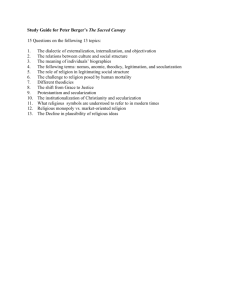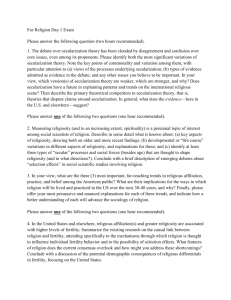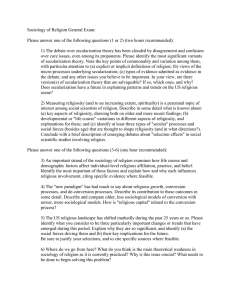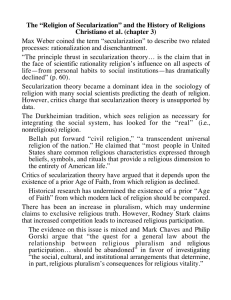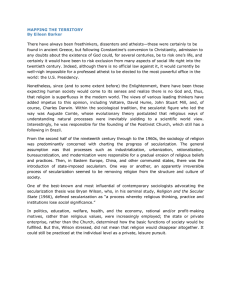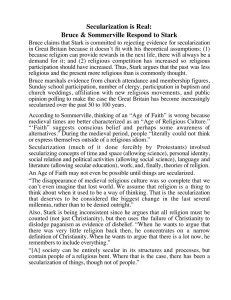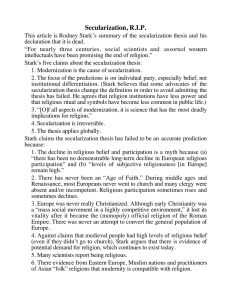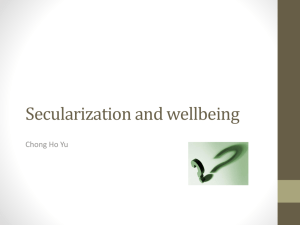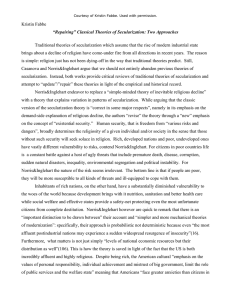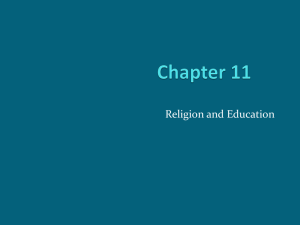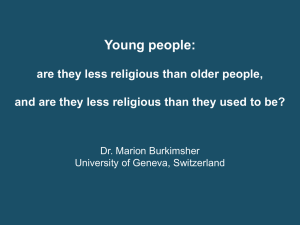COMPREHENSIVE EXAM – RELIGION (GENERAL) TAKE HOME
advertisement
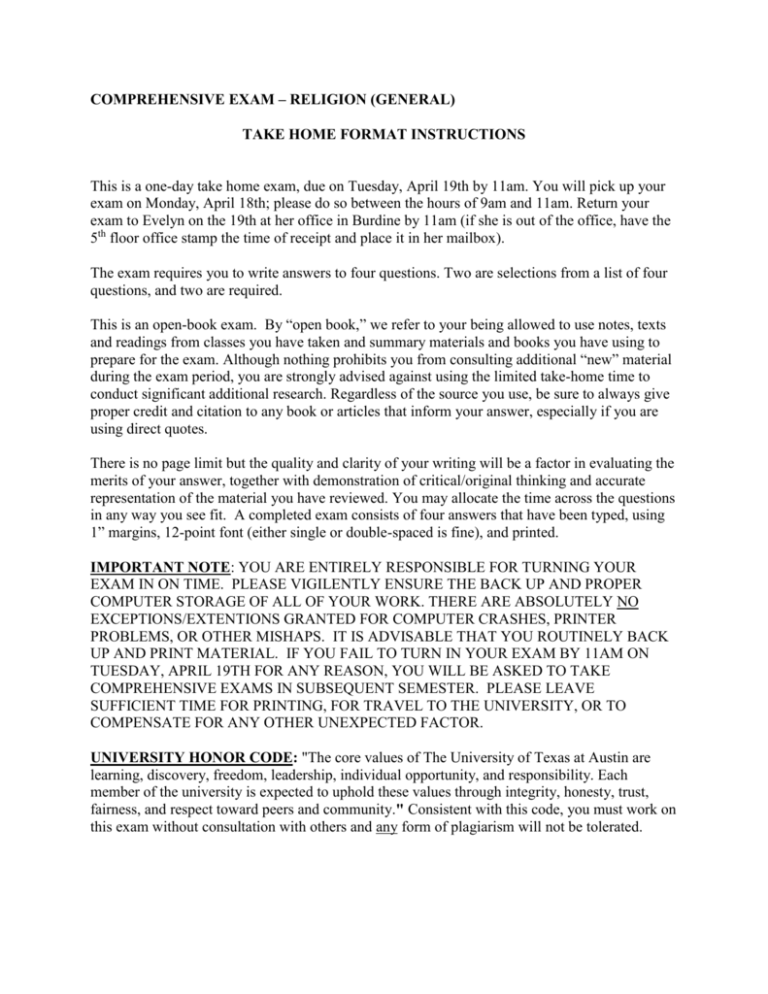
COMPREHENSIVE EXAM – RELIGION (GENERAL) TAKE HOME FORMAT INSTRUCTIONS This is a one-day take home exam, due on Tuesday, April 19th by 11am. You will pick up your exam on Monday, April 18th; please do so between the hours of 9am and 11am. Return your exam to Evelyn on the 19th at her office in Burdine by 11am (if she is out of the office, have the 5th floor office stamp the time of receipt and place it in her mailbox). The exam requires you to write answers to four questions. Two are selections from a list of four questions, and two are required. This is an open-book exam. By “open book,” we refer to your being allowed to use notes, texts and readings from classes you have taken and summary materials and books you have using to prepare for the exam. Although nothing prohibits you from consulting additional “new” material during the exam period, you are strongly advised against using the limited take-home time to conduct significant additional research. Regardless of the source you use, be sure to always give proper credit and citation to any book or articles that inform your answer, especially if you are using direct quotes. There is no page limit but the quality and clarity of your writing will be a factor in evaluating the merits of your answer, together with demonstration of critical/original thinking and accurate representation of the material you have reviewed. You may allocate the time across the questions in any way you see fit. A completed exam consists of four answers that have been typed, using 1” margins, 12-point font (either single or double-spaced is fine), and printed. IMPORTANT NOTE: YOU ARE ENTIRELY RESPONSIBLE FOR TURNING YOUR EXAM IN ON TIME. PLEASE VIGILENTLY ENSURE THE BACK UP AND PROPER COMPUTER STORAGE OF ALL OF YOUR WORK. THERE ARE ABSOLUTELY NO EXCEPTIONS/EXTENTIONS GRANTED FOR COMPUTER CRASHES, PRINTER PROBLEMS, OR OTHER MISHAPS. IT IS ADVISABLE THAT YOU ROUTINELY BACK UP AND PRINT MATERIAL. IF YOU FAIL TO TURN IN YOUR EXAM BY 11AM ON TUESDAY, APRIL 19TH FOR ANY REASON, YOU WILL BE ASKED TO TAKE COMPREHENSIVE EXAMS IN SUBSEQUENT SEMESTER. PLEASE LEAVE SUFFICIENT TIME FOR PRINTING, FOR TRAVEL TO THE UNIVERSITY, OR TO COMPENSATE FOR ANY OTHER UNEXPECTED FACTOR. UNIVERSITY HONOR CODE: "The core values of The University of Texas at Austin are learning, discovery, freedom, leadership, individual opportunity, and responsibility. Each member of the university is expected to uphold these values through integrity, honesty, trust, fairness, and respect toward peers and community." Consistent with this code, you must work on this exam without consultation with others and any form of plagiarism will not be tolerated. Please answer both of the following two questions: 1. The debate over secularization theory has been clouded by disagreement and confusion over core issues, even among its proponents. Please identify the most significant variants of secularization theory. Note the key points of commonality and variation among them, with particular attention to (a) views of the processes underlying secularization; (b) types of evidence admitted as evidence in the debate; and any other issues you believe to be important. In your view, which version(s) of secularization theory are weaker, which are stronger, and why? Does secularization have a future in explaining patterns and trends on the international religious scene? 2. Measuring religiosity (and to an increasing extent, spirituality) is a perennial topic of interest among social scientists of religion. Describe in some detail what is known about: (a) key aspects of religiosity, drawing both on older and more recent findings; (b) developmental or “life course” variations in different aspects of religiosity, and explanations for these; and (c) identify at least three types of “secular” processes and social forces (besides age) that are thought to shape religiosity (and in what directions?). Conclude with a brief description of emerging debates about “selection effects” in social scientific studies involving religion. Please answer two of the following four questions: 3. For decades, one daunting problem in the social scientific study of religion was the absence of any overarching theoretical perspective aside from secularization. Beginning in the late 1980s, rational choice theory has filled that gap for many prominent social scientists. Please outline the key features of this “new paradigm,” noting the multiple levels (i.e., micro-, mezzo-, and macrolevel) of this approach as developed by Iannaccone, Finke, and Stark. It has had much to say about religious growth, conversion processes, and de-conversion processes. Describe its contribution to these outcomes in some detail. How is “religious capital” related to the conversion process? And what is your view of the strengths and weaknesses of the micro-level rational choice perspective? How does it illuminate or obscure key features of individual religious life? Please be specific. 4. Religious practice in the West is markedly different in a number of ways from religious practice in the nonwestern world. Please describe in some detail the major religious trends in a nonwestern region of your choice (e.g., Latin America, the Middle East, etc.), comparing it broadly to the West. Does the term “religion” as an analytic category even fit in that region? If not, why not? How are religious trends in that region sensitive to issues of population such as fertility, migration, and mortality? 5. In your view, what are the three (3) most important, far-reaching trends in religious affiliation, practice, and belief among the American public? What are their implications for the ways in which religion will be lived and practiced in the US over the next 30-40 years, and why? Finally, please offer your most persuasive and nuanced explanations for each of these trends, and indicate how a better understanding of each will advance the sociology of religion. 6. Increasing attention is being given to what scholars have called religious “contexts.” Describe in some detail what is meant by the term, how they have been variously measured, and how they is thought to be influential (on what? under what circumstances?). Are there general conclusions about such contextual studies involving religion that can be identified?
